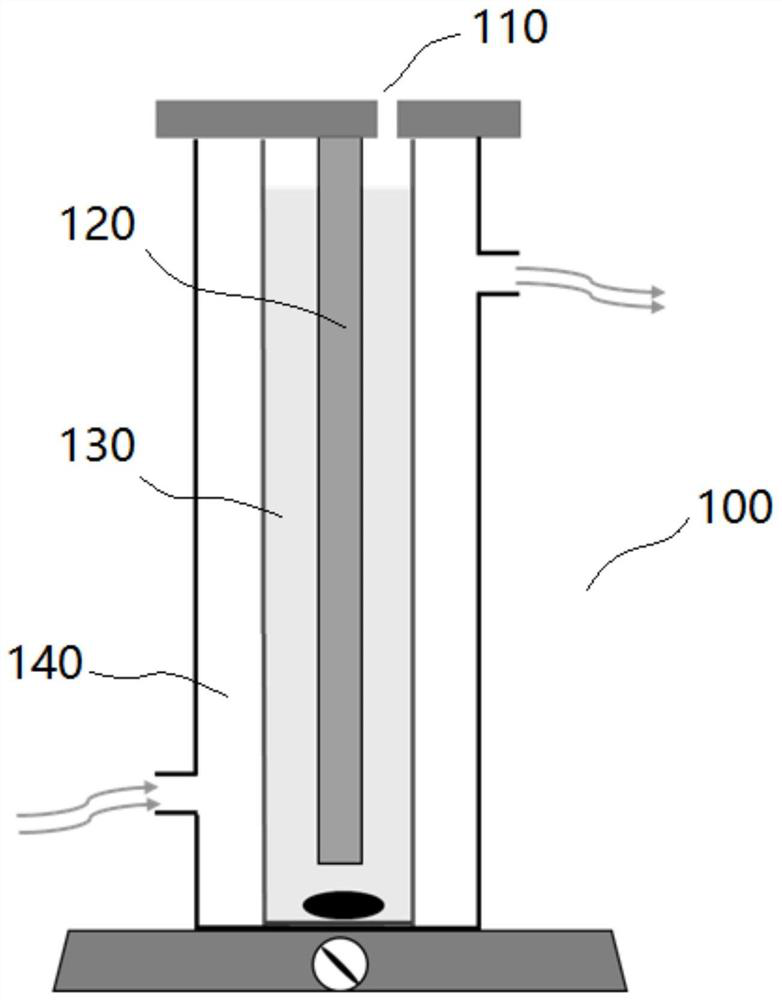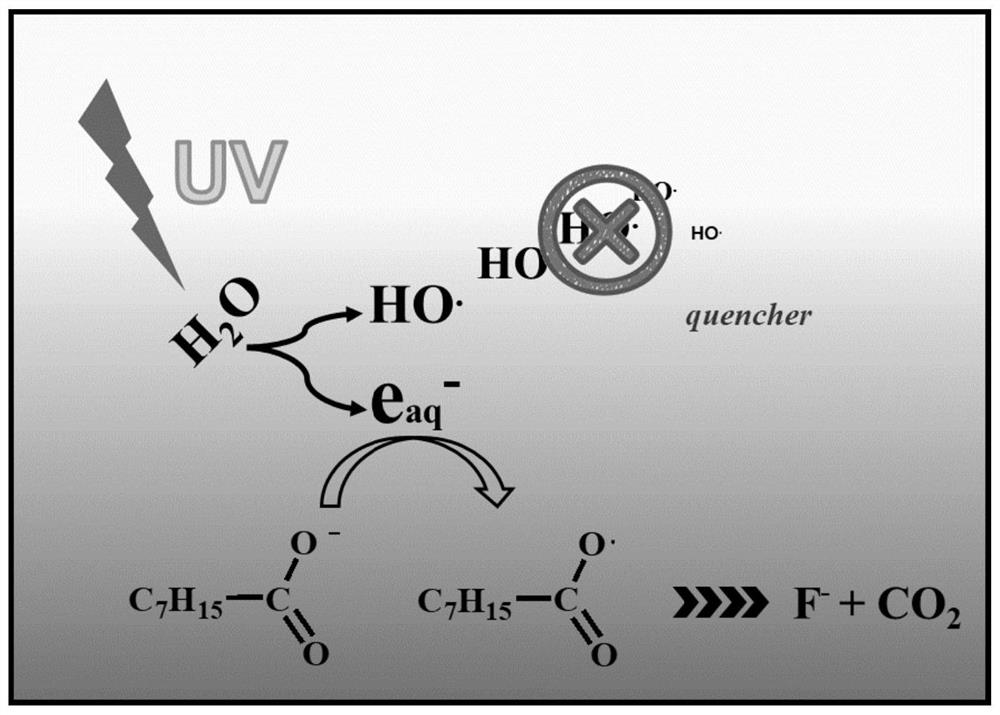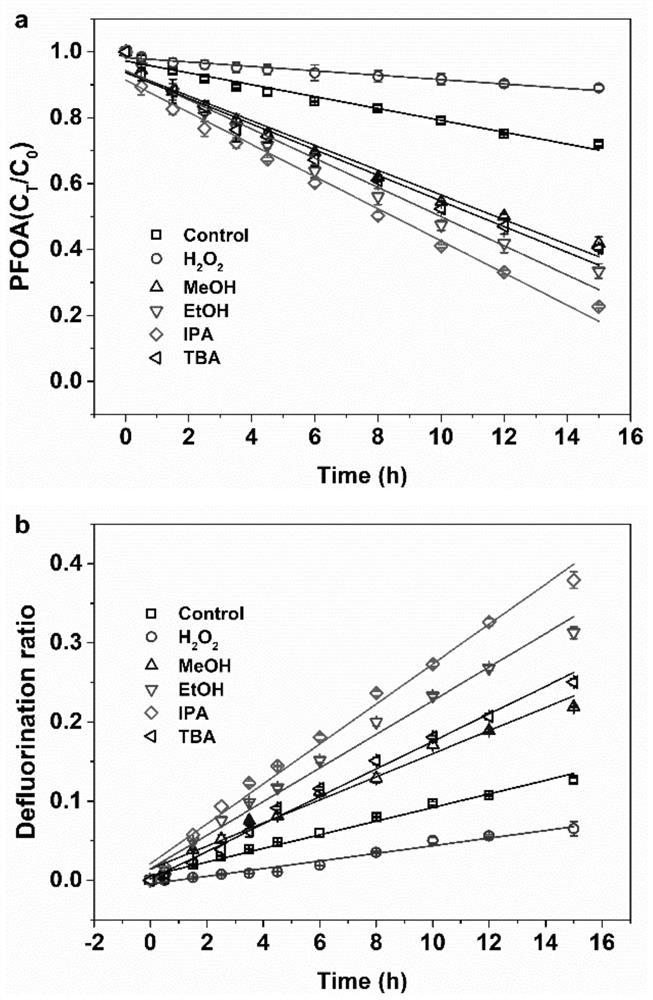A method of enhancing ultraviolet photolysis of perfluoroalkyl compounds in water
A technology of perfluoroalkyl compounds, applied in the field of enhancing ultraviolet photolysis of perfluoroalkyl compounds in water bodies, can solve the problems of poor effect of perfluoroalkyl compounds, unstable hydrated electrons, etc. Implement and improve the effect of degradation efficiency
- Summary
- Abstract
- Description
- Claims
- Application Information
AI Technical Summary
Problems solved by technology
Method used
Image
Examples
Embodiment 1
[0043] The present embodiment mainly investigates the degradation and defluorination effects of different quenchers on PFOA, and the specific steps are:
[0044] (1) Transfer 300 mL of a mixture containing 65.0 mM methanol, ethanol, isopropanol, tert-butanol, hydrogen peroxide solution and 0.0242 mM PFOA solution into a cylindrical quartz photoreaction tube (usually, d=41 mm, h=400 mm) , and set 300 mL of PFOA solution containing only 0.0242 mM as a blank control, and transfer it to the same photoreaction tube for the same experiment, and adjust the pH of the above-mentioned different mixed solutions and control solutions to 10;
[0045] (2) Using a 36W low-pressure mercury lamp as a light source to irradiate the different mixed solutions and control solutions obtained in step S10, a photoreaction experiment was performed, the reaction temperature was controlled at 25±1°C, and the reaction time was 15 hours.
[0046] The sampling time was set to 0h, 0.5h, 1.5h, 2.5h, 3.5h, 4.5...
Embodiment 2
[0049] The present embodiment mainly investigates the types of free radicals in different quencher systems, and its specific steps are:
[0050] (1) Prepare 20 mL of 65.0 mM methanol, ethanol, isopropanol and tert-butanol solutions respectively, and set up a solution containing only 20 mL of ultrapure water as a blank control, and adjust the pH of the above different solutions to 10, followed by nitrogen aeration Deoxygenation for half an hour;
[0051] (2) The above solutions were respectively transferred to five 20 mL glass tubes, and the radical scavenger lutidine N-oxide (DMPO) was added, wherein the concentration of DMPO was 20 mM. Use a 180W mercury lamp as a light source to irradiate the above solution, after 1min of irradiation, sample 20 μL into the capillary, and then detect the free radical signal by an electron paramagnetic resonance spectrometer. The signal intensities of different free radicals are as follows: Figure 4 a and Figure 4 b shown.
[0052] Depend...
Embodiment 3
[0054] The present embodiment mainly investigates the degradation and defluorination effects of alcohol radicals on PFOA, and the specific steps are:
[0055] (1) Prepare 50 mL of 400.0 mM methanol, ethanol, isopropanol and tert-butanol solutions respectively, 100 mg L -1 10mL of PFOA solution, 10mL of 100.0mM persulfate solution, add ultrapure water to mix the above alcohol solution, PFOA solution and persulfate solution to 100mL, so that alcohols, PFOA and persulfate in the mixed solution The concentrations of PFOA were 200mM, 0.0242mM and 10.0mM respectively; at the same time, 100mL of PFOA solution containing only 0.0242mM was set as a blank control, and the pH value of the above mixed solution was adjusted to 10;
[0056] (2) Utilize a constant temperature water bath as a heating device to carry out a heating reaction to the above mixed solution, the reaction time is 25 hours, and the reaction temperature is controlled at 50±1°C.
[0057] The sampling time is set to 0h, ...
PUM
 Login to View More
Login to View More Abstract
Description
Claims
Application Information
 Login to View More
Login to View More - R&D
- Intellectual Property
- Life Sciences
- Materials
- Tech Scout
- Unparalleled Data Quality
- Higher Quality Content
- 60% Fewer Hallucinations
Browse by: Latest US Patents, China's latest patents, Technical Efficacy Thesaurus, Application Domain, Technology Topic, Popular Technical Reports.
© 2025 PatSnap. All rights reserved.Legal|Privacy policy|Modern Slavery Act Transparency Statement|Sitemap|About US| Contact US: help@patsnap.com



